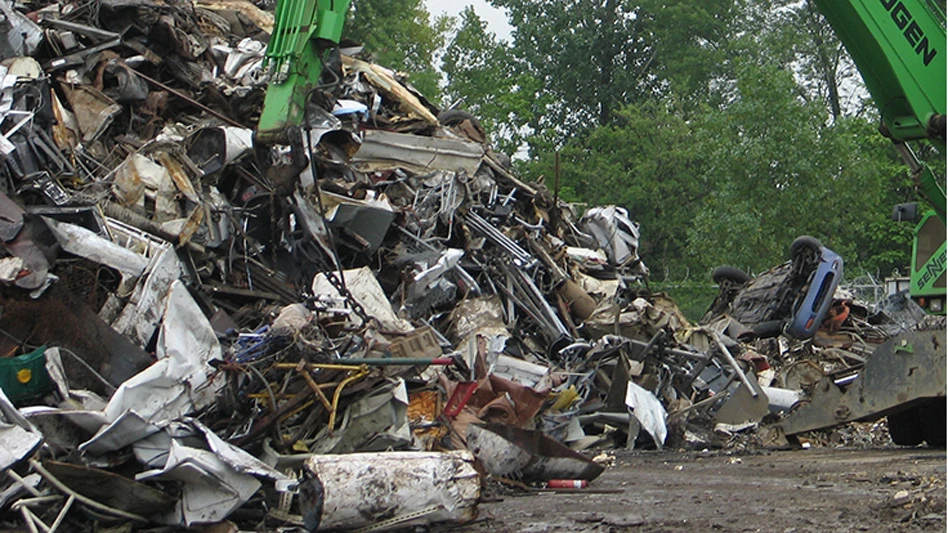
Recycling Today archives
Steel mill buyers let it be known as the new year started that they intended to lower their bids for ferrous scrap by as much as $50 per ton in the January 2024 market compared with December 2023 prices.
“We are expecting a soft ferrous market for January,” an auto dismantler told Recycling Today at the end of the first week of that month. Although domestic mill buyers sought to peel back the $35 to $70 per ton of value ferrous grades had just earned in the prior month, they have not been successful entirely.
At the conclusion of the second full week in January, an active export market helped processors nearly hold the line on the asking price of shredded scrap and No. 1 heavy melting steel (HMS).
Export market leverage did not provide the same type of help for prompt grades, however, with metals pricing information service Davis Index reporting that some prime scrap grades were being purchased by domestic mills for $30 per ton less than what they fetched in December.
The positive effects of steady orders from Turkey (and Mexico) demonstrated geographic limits in January. According to Davis Index, while East Coast and Gulf Coast export prices were able to hold steady, Pacific Coast shippers were accepting bids down from $5 to $15 per ton in their less active market.
That domestic mills, in many cases, were unable to get the steep discounts they sought in January could set the table for a sellers’ market in early 2024, at least if steel production figures hold steady in the U.S. and in key export markets including Turkey, Mexico and India.
In November 2023, scrap-fed melt shops at Turkey’s numerous electric arc furnace (EAF) mills showed an encouraging level of activity.
The 3 million metric tons of steel made in Turkey in November represented a 25.4 percent uptick in output compared with one year earlier, according to Turkish national steel association figures provided to the Brussels-based World Steel Association (Worldsteel).
India’s steel sector enjoyed steady growth in 2023, as it has for several consecutive years. The 11.7 million metric tons of steel made in India last November is 11.4 percent higher in volume than its November 2022 production level.
Overall, India is likely to have made about 12 percent more steel in 2023 than it did in 2022. The active November in Turkey, meanwhile, helped it close its year-on-year output decline to about 6.1 percent, Worldsteel says. That is a marked improvement from the 16.3 percent output decline figure Turkey had posted at midyear 2023.
In Mexico, two plans for EAF capacity increases were announced last year. Even before that capacity comes online, Davis Index in mid-January was characterizing the Mexican ferrous market as one driven by “unrelenting demand.”
Data collected by the U.S. Census Bureau and published by the U.S. Geological Service (USGS) points to Mexico’s growing role in the U.S. scrap market.
In the first seven months of 2023, Mexican mills and foundries received 1.29 million metric tons of ferrous scrap imported from the U.S., valued at a combined $386 million, according to the USGS.
The level of shipments to Mexico has the nation ranked second as a buyer of exported U.S. ferrous scrap, behind only Turkey. Mexico’s importance as a destination could grow when the announced steel industry investments come to fruition.
In November, Italy-based Danieli & C. S.p.A. announced steel producer DeAcero had contracted with Danieli to equip a planned 1.5 million tons-per-year EAF melt shop at its Ramos Arizpe campus in northeast Mexico.
DeAcero clearly intends to source more of the scrap it needs domestically. Along with its EAF equipment, the company has ordered five metal shredding plants from Danieli Centro Recycling to be placed in different cities in Mexico.
In February of last year, the board of directors of Luxembourg-based steelmaker Ternium SA approved the construction of a 2.6-million-ton-per-year electric arc furnace (EAF) steel slab production facility in northern Mexico.
In the U.S., steelmakers largely managed profitable production in 2023, though not nearly at the record levels many enjoyed in 2022. Conditions were favorable enough last year for melt shops in the U.S. to produce just as much steel as they did the highly profitable year before.
According to the Washington-based American Iron & Steel Institute (AISI), as of Dec. 30, 2023, steelmakers in the U.S. had made about 88.7 million tons of crude steel, up by 0.2 percent from the approximately 88.5 million tons one year earlier.
Even while acknowledging tighter profit margins throughout 2023, steel company executives largely have portrayed their order books and the demand landscape as being healthy.
“Performance in our North America Steel Group was supported by sustained healthy construction activity,” Peter Matt, the president and CEO of Texas-based CMC, said when reviewing the firm’s financial quarter that ended Nov. 30, 2023.
In mid-December 2023, EAF producer Steel Dynamics Inc. (SDI), Fort Wayne, Indiana, warned of tighter profit margins while also portraying demand for steel as healthy.
“Steel order activity remains solid, as evidenced by extended order lead times and recent pricing increases heading into the first quarter of 2024,” the firm stated at that time.
Although the upward price momentum that struck this past December did not sustain itself into January, scrap generators and processors may find that ongoing global demand for both steel and ferrous scrap will bring that momentum back again soon.
Latest from Recycling Today
- BMW Group, Encory launch 'direct recycling’ of batteries
- Loom Carbon, RTI International partner to scale textile recycling technology
- Goodwill Industries of West Michigan, American Glass Mosaics partner to divert glass from landfill
- CARI forms federal advocacy partnership
- Monthly packaging papers shipments down in November
- STEEL Act aims to enhance trade enforcement to prevent dumping of steel in the US
- San Francisco schools introduce compostable lunch trays
- Aduro graduates from Shell GameChanger program





